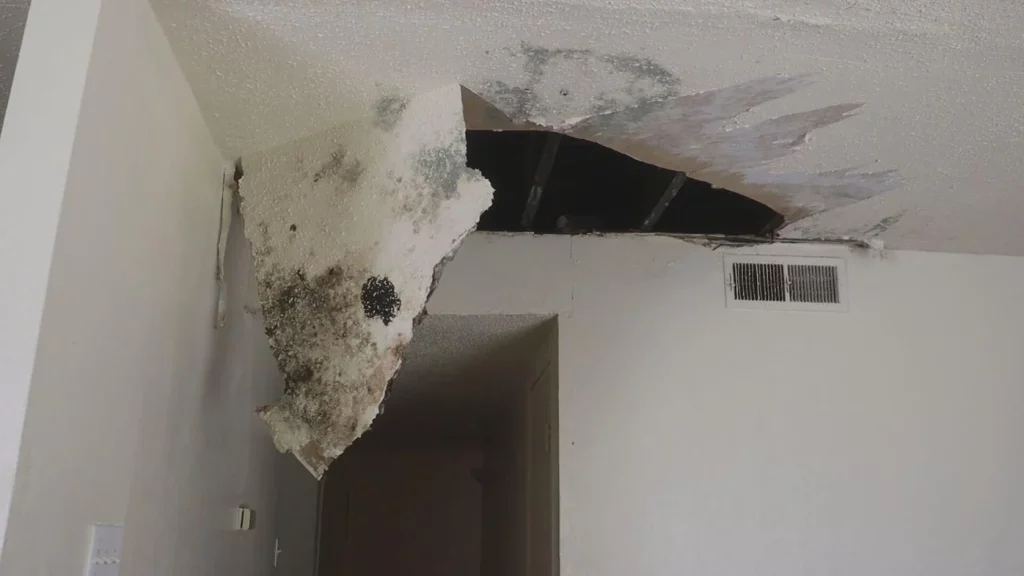Water damage is a homeowner’s nightmare, and when your ceiling caves in due to water damage, it can be a devastating experience. In this article, we’ll explore the causes, effects, and crucial steps to take when facing the aftermath of a ceiling caved in water damage.

Introduction
Imagine coming home to find your ceiling collapsed, water pouring in from above, causing extensive damage to your belongings. The scenario is not only distressing but also poses immediate challenges that need urgent attention. Understanding the causes and knowing what steps to take can make a significant difference in mitigating the damage.
Causes of Ceiling Caved In Water Damage
Water damage leading to a collapsed ceiling can stem from various sources. It could be a burst pipe, roof leakage, plumbing issues, or even severe weather conditions like storms and heavy rainfall. Identifying the root cause is crucial in preventing future incidents.
Effects of Ceiling Caved In Water Damage
The consequences of a ceiling caved in due to water damage are extensive and can affect both the structural integrity of your home and the safety of its occupants. Immediate effects include ruined furniture, damaged electronics, and compromised living spaces. Long-term repercussions may include mold growth, which poses health risks and requires professional remediation.
Dealing with the Immediate Aftermath
1. Ensure Safety First
The first and foremost concern after a ceiling collapse is safety. Evacuate the affected area, especially if there are electrical appliances or if the structure seems unstable. Prioritize the safety of everyone in the household.
2. Turn Off Utilities
To prevent further damage and ensure safety, turn off water and electricity sources in the affected area. This will help minimize the risk of electrical shocks and additional water leakage.
3. Document the Damage
Before cleaning up or making any repairs, document the damage. Take photographs and videos of the affected areas, as these will be crucial for insurance claims and assessments.
4. Contact Professionals
Ceiling caved in water damage often requires professional assistance. Contact a reliable water damage restoration company to assess the extent of the damage and formulate an effective restoration plan.
Ceiling Caved In Water Damage Restoration Process
1. Water Extraction
The first step in the restoration process is water extraction. Specialized equipment is used to remove standing water and moisture from the affected areas.
2. Structural Drying
Once the water is removed, the next step is structural drying. This involves using dehumidifiers and air movers to eliminate any remaining moisture, preventing mold growth and further damage.
3. Repairs and Restoration
With the area dried, repairs can begin. This may include fixing the ceiling, replacing damaged drywall, and addressing any structural issues. Restoration professionals have the expertise to restore your home to its pre-damaged condition.
Read too: Unveiling the Secrets: Understanding and Optimizing R Value for Basement Ceiling Insulation
Preventing Future Incidents
To prevent ceiling caved in water damage in the future, consider the following measures:
1. Regular Inspections
Regularly inspect your roof, plumbing, and ceilings for signs of damage or wear. Identifying issues early can prevent them from escalating into major problems.
2. Adequate Insulation
Ensure your home is adequately insulated to prevent issues like ice dams and roof leaks. Proper insulation can also regulate indoor temperatures, reducing the risk of condensation.
3. Prompt Repairs
Address any leaks or plumbing issues promptly. Even small leaks can lead to significant water damage over time.
Conclusion
Experiencing a ceiling caved in due to water damage is undoubtedly stressful, but knowing how to respond can make a significant difference. By taking immediate action, seeking professional assistance, and implementing preventive measures, homeowners can navigate through the challenges of water damage and restore their homes to a safe and habitable condition. Remember, the key is to act swiftly and efficiently in the face of adversity.
